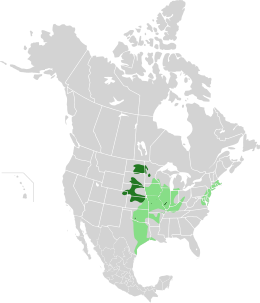Greater prairie chicken
| Greater prairie chicken | |
|---|---|
 |
|
| Male displaying in Illinois, USA | |
| Scientific classification | |
| Kingdom: | Animalia |
| Phylum: | Chordata |
| Class: | Aves |
| Order: | Galliformes |
| Family: | Phasianidae |
| Genus: | Tympanuchus |
| Species: | T. cupido |
| Binomial name | |
|
Tympanuchus cupido (Linnaeus, 1758) |
|
| Subspecies | |
|
Tympanuchus cupido attwateri |
|
 |
|
| Distribution map of the Greater Prairie-Chicken. Pale and dark green: pre-settlement Dark green: current year-round |
|
| Synonyms | |
|
Tetrao cupido |
|
Tympanuchus cupido attwateri
Tympanuchus cupido cupido†
Tympanuchus cupido pinnatus
Tetrao cupido
The greater prairie chicken or pinnated grouse (Tympanuchus cupido), sometimes called a boomer, is a large bird in the grouse family. This North American species was once abundant, but has become extremely rare and extirpated over much of its range due to habitat loss. Conservation measures are underway to ensure the sustainability of existing small populations. One of the most famous aspects of these creatures is the mating ritual called booming.
Adults of both sexes are medium to large chicken-like bird, stocky, with round-wings. They have short tails which are typically rounded and blue in color. Adult males have orange comb-like feathers over their eyes and dark, elongated head feathers that can be raised or lain along neck. They also possess a circular, un-feathered neck patch which can be inflated while displaying; this, like their comb feathers, is also orange. As with many other bird species, the adult females have shorter head feathers and also lack the male's yellow comb and orange neck patch.
There are three subspecies;
Greater prairie chickens prefer undisturbed prairie and were originally found in tall grass prairies. They can tolerate agricultural land mixed with prairie, but fewer prairie chickens are found in areas that are more agricultural. Their diet consists primarily of seeds and fruit, but during the summer they also eat insects and green plants. These birds were once widespread all across the oak savanna and tall grass prairie ecosystem.
The greater prairie chicken was almost extinct in the 1930s due to hunting pressure and habitat loss. They now only live on small parcels of managed prairie land. It is thought that their current population is approximately 459,000 individuals. In May 2000, the Canadian Species at Risk Act listed the greater prairie chicken as extirpated in its Canadian range (Alberta, Saskatchewan, Manitoba, Ontario). It was again confirmed by the Committee on the Status of Endangered Wildlife in Canada in November 2009. Nonetheless, sightings and encounters continue to occur in the south-central regions of Alberta and Saskatchewan, along with southern Ontario where sightings are extremely rare.
...
Wikipedia

